The Barber of Seville online course by Dr. Paul DorganPart 4: Bel Canto
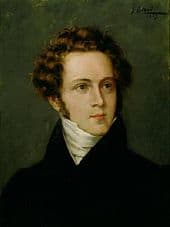
Vincenzo Bellini
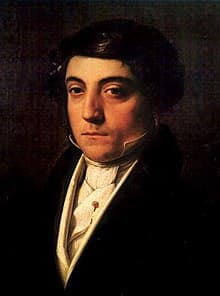
Gioacchino Rossini
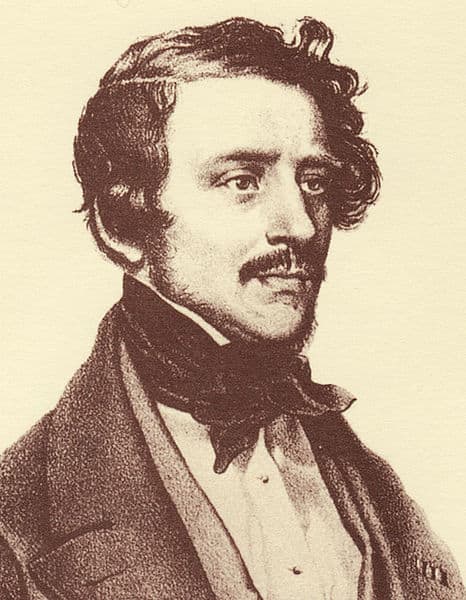
Gaetano Donizetti
Opera historians tell us that the years in which Gioacchino Rossini (1792 – 1868); Gaetano Donizetti (1797 – 1848); and Vincenzo Bellini (1801 – 1835) were composing operas for European theatres is the Bel Canto Era. Which, beginning with Rossini’s first opera (1810) and ending with Donizetti’s last (1843), was a mere 30-year span; can such a short time be called an “Era”? For the sake of avoiding an argument, let’s assume it is. What the historians avoid, in this generalization, is a definition of the very term which forms the basis of their research!
So, what does Bel Canto mean?
What it doesn’t mean, in this context, is Ann Patchett’s 2001 novel of the same title, together with its operatic (2015) and movie (2018) versions!
A literal translation of bel canto means “beautiful song,” or “beautifully sung.” But don’t we hope for that whenever we hear a singer sing anything, whether it be by Monteverdi; Bach; Donizetti; Verdi; Puccini; Strauss; Wagner; Bellini; Britten; Berg or George Crumb? We do. Though how many operas (and not necessarily the “biggies” of Wagner and Strauss) have we sat through hearing singers bark their way through their roles? And yet Wagner considered Bellini’s Norma “…the richest in the profoundly realistic way in which true melody is united with intimate passion.” Utah Opera finally produced it last season.
The term first appears in late 17th-century Italy, but it became more widely used and accepted in the middle of the next century with the operas of Handel (you may have seen Utah Opera’s Giulio Cesare in 2004); Glück (Orfeo e Euridice in 2000); and Mozart (who makes regular appearances here), and it refers to the training young singers were given by their teachers, who were often retired castrati. (Side bar: Anne Rice’s novel Cry to Heaven includes much information about the vocal training of a youth who’s been castrated.) Rossini believed that “bel canto is made up of three elements: 1. The instrument – the voice…; 2. Technique – that is to say, the means of using it; 3. Style, the ingredients of which are taste and feeling.” The first three years of vocal study would, in his syllabus, concentrate on ensuring that each vowel be perfectly sounded, no matter the pitch; then came the study of diphthongs; consonants, articulation; breathing; followed, in Rossini’s words, by the wonderful “etc.” Such training would take about 5 years for women and 7 for men. The result would be impeccable legato throughout the range; the vocal agility to deal with elaborate decorations of the vocal line; clear diction; use of a light tone (falsetto?) in the higher registers of tenors: he strongly objected to those “who work up a sweat producing the painful chest-voice high C, or even, God forbid, the chest-voice high C#, which I would never have dreamed of!” (Obviously referring to Duprez – see below!) There was to be little vibrato: “I always found it disagreeable…to have my music performed by singers who…think they have to illustrate every note with a sort of tremolio in their voice (it seems more like an attack of epilepsy)…”
This training, once the vocal basics were mastered, emphasized the text, and the necessity to treat it as a great orator might. So each punctuation mark should have its own space: a comma, for instance, would be given a beat, and so on up to the period, which could receive four beats before continuing. And, as with any great public speaker, some phrases of the text would be hurried through while others would be lingered over for emphasis: “rubato.” One of my early piano teachers described the term as “robbing Peter to pay Paul” – slowing up in certain places, followed by a quickening back to the basic tempo, or the opposite.
In 2013 Robert Toft published Bel Canto: A Performer’s Guide, an astonishing book backed up by his meticulous research into writings of the period: treatises on singing; newspaper reports of performances; published music which notated how certain singers actually sang “Songs taken from the Great Composers” – or whatever the volumes were called. He even transcribes a recording of Mozart’s “Voi che sapete” from Le nozze di Figaro made around 1906 by the great soprano Adelina Patti (1843 – 1919), who Verdi considered one of the finest singers ever and a “stupendous artist.” Let me just tell you that if a singer today sang the aria à la Patti she would be severely criticized! Toft’s book is too technical for the general reader, but consider one of his statements: the notes written down by the composer are only a guide. Which, the inference is, should not be faithfully adhered to, and Patti’s recording of the Mozart aria proves the point: listen to it on youtube and see what you think. Which is small consolation to those of you who, as students, struggled to get the notes and rhythms right, and, when you didn’t, endured mean and nasty comments from your teachers: an early piano teacher once whacked my knuckles with a pencil when I played a wrong note: had I known better then I’d have claimed it as an “ornament” – how times have changed!
The singers trained in this bel canto technique would have included the first performers in Monteverdi’s operas (his final opera, L’incoronazione di Poppea, first given in 1643, was produced by Utah Opera in 1998); Handel’s operas; and those of Christoph von Glück. And it is from their rigorous vocal training that those early performers of Mozart’s operas, including Madame Patti, would have inherited their freedom to play with the composer’s notation. In 1965, at London’s Sadlers Wells Opera (now the English National Opera), Charles Mackerras (he wasn’t a “Sir” then!) conducted a production of Mozart’s The Marriage of Figaro (operas there are sung in an English translation) which tried to recreate the score as it might have been performed in Mozart’s time; the results, apparently, were mixed, and Mackerras later admitted that he might have gone too far with his ornaments and decorations. But at least he tried! Why should we, today, not accept that the singer of, say, a Mozart aria, be allowed, in the true bel canto tradition, to decorate the notes as Patti did? Mozart would surely have expected it. Today, we accept/expect a singer to decorate/ornament such repeats in the operas of Bellini; Donizetti; and Rossini, why not in Mozart, or Beethoven? The answer is that most of today’s critics would rail against it. But, as Anne Ewers (remember her?) reminded me once: “critics are to art as pigeons are to statues”!
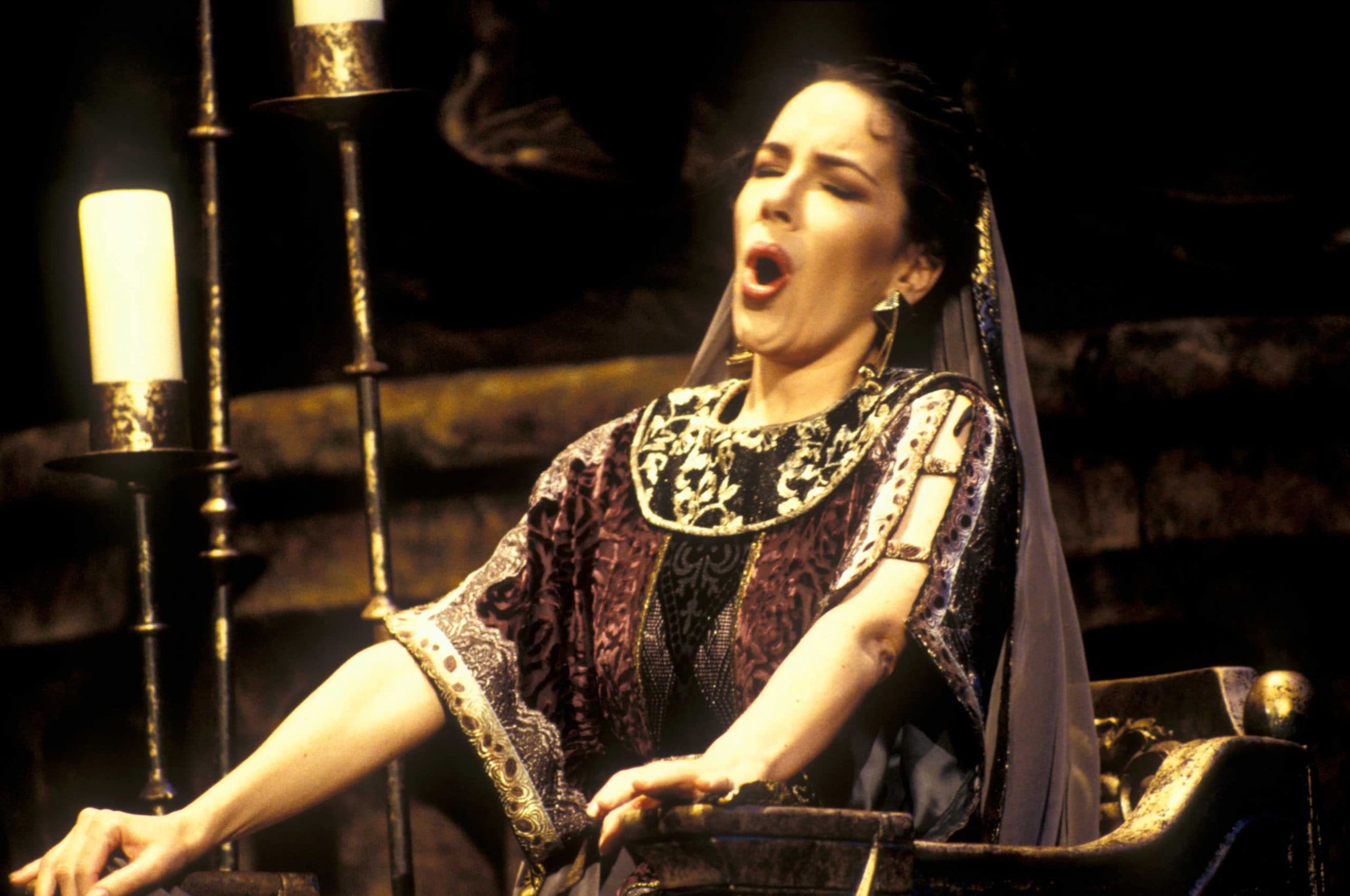
L’incoronazione di Poppea, produced by Utah Opera in 1998
Many opera arias by composers of the 18th and early 19th centuries, especially those by Handel (Bach too; but here we’re concerned only with opera) and Mozart, are in an A-B-A plan, with the repeat of the A section allowing the singer to re-inforce the original emotion with vocal decorations, often leading to a moment towards the end where the singer can improvise a cadenza. You, who’ve sat through so many concertos at Utah Symphony concerts, know that that’s when, at the end of the first movement (and sometimes in the last movement as well) the orchestra quits playing while the soloist doodles around with the themes we’ve already heard with the express intention of wowing you, the audience-member, with his/her virtuosity. Those earlier composers left it to the soloist to improvise; later ones tended to write their own, if only to prevent a repetition of Handel’s “Welcome Home!” quip to the singer who doodled himself into such strange tonalities that when he finally returned to the original key, he was thus greeted by Handel! A more recent example of the dangers of improvising a cadenza comes in the 1964 movie The World of Henry Orient: Peter Sellers plays a concert pianist and there’s a sequence which shows him arriving at the end of a cadenza, which, from the conductor’s reaction, is not in the correct key; the third time is the charm; unfortunately the conductor does not repeat Handel’s words. Obviously both Handel’s soloist and Henry Orient got carried away with their improvisations. Such excesses are obviously wrong. Which begs the question “what is excess?” Here is not the place to answer that!
Rossini’s solution to what he considered “excess” was simple: write the decorations/embellishments into the vocal lines. Some pages of his scores are black with the multitude of notes he requires of the singer. Which is not to say he was dogmatic about his own embellishments: he wasn’t; and even re-wrote some for certain singers. His attitude to “excess” was perfectly exemplified when, at one of his soirées in the 1860’s, the young Adelina Patti sang for him his own “Una voce poco fà” from Il barbiere di Siviglia; he complimented her voice, but wondered, given her elaborate (excessive?) decorations/embellishments , who had composed the aria? Two years earlier he had lamented the loss of “our bel canto,” which could not have been the complaint of a composer suddenly out-dated by newer trends – his last opera, Guillaume Tell, had had its premiere in 1829, some 30 years before his lament. Perhaps it was a reaction to the operas of Giacomo Meyerbeer (1791 – 1864) whose Parisian successes including Les Huguenots (1836) and Le Prophète (1849) had been Grander Opera, with their more elaborate choral scenes and their richer orchestral writing, than any Grand Opera the Paris Opéra had seen till then. And then there was the French tenor Gilbert Duprez (1806 – 1896) who, with limited flexibility, had had a mediocre career until he moved to Italy and figured out how to sing a high C from his chest – a very exciting sound, even today. Ironically, he triumphed in the Italian premiere of Guillaume Tell in 1831, singing his chest high C’s. Rossini objected to the sound and, when the tenor called on him, he was told to leave his chest-voice C at the door! Rossini and his fellow bel-cantists (not to mention their predecessors) would have expected their tenors to use “head voice” in their higher range (a lighter/ kind of falsetto sound), which allowed those composers to include notes which are out of the reach of most tenors today, though Juan Diego Flórez and Javier Camerena are welcome exceptions.
Over the years the term bel canto lost its connection to the actual training of a singer and attached itself to the way composers, especially Rossini; Donizetti; and Bellini, wrote for those singers and for the orchestra which accompanied them. With Handel and Mozart the orchestra is an equal partner in the singers’ arias, and you’re never aware of it as a mere “accompaniment”; sometimes those composers will add a solo instrument to mirror, or comment on, or reinforce the emotion of the vocal line: think of the trumpet in “The trumpet shall sound” from Messiah; or the clarinet in Sesto’s “Parto, parto” from Mozart’s La clemenza di Tito. But in virtually all of the arias of our Italian trio of bel canto composers (now there’s a sweeping generalization for you!) the orchestra, despite what it might do in the introductions; the interludes; or the postludes, is simply an accompanist, providing the singers with the basic harmonic underpinning to support their vocal expression of the emotions of the text, and it is the solo vocal line which is the principal conveyor of those emotions.
Which is ideally realized in Bellini’s Norma, as Wagner noted. But I hope you will notice that also in Barbiere: the voice dominates the texture, with the orchestra being an obedient servant to the singer’s need to express the text. Take, for example, Rosina’s first aria, where she tells us about the voice she’s recently heard. There’s excitement in the dotted rhythm of her first words: “I just heard a voice,” and then a kind of sighing {but also some giggling?) in “Which echoed in my heart.” Excitement again with “My heart was wounded” (but obviously a happy wound!), but isn’t that love when she tells us it was “Lindoro”? Then determination when she swears that Lindoro will be hers. And that’s just the opening paragraph! Surely Rosina’s words demand a flexibility of tempo to express her feelings, and Rossini, with his bare-bones orchestral accompaniment, allows her the musical space to do that.
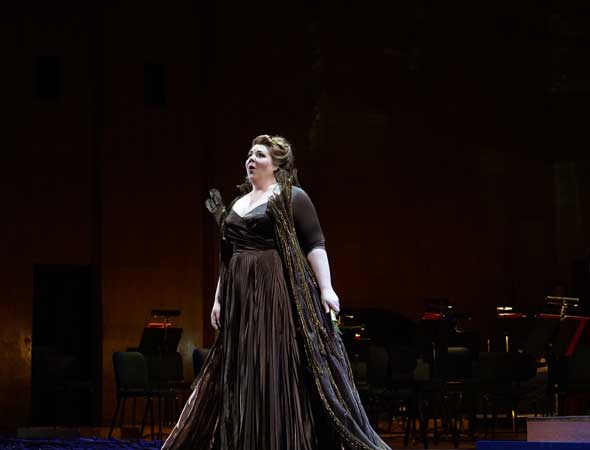
Utah Opera’s production of Norma, 2019
Rosina’s aria is as perfect an example of bel canto, in both of the meanings I’ve described above, as anything in Norma. Bellini’s opera is a tragedy, while Rossini’s is a comedy, and there’s a snobbish tendency to consider the former more lofty than the latter, and therefore Il barbiere di Siviglia must rank a few rungs lower on the opera ladder than, say, Norma. But bel canto remains bel canto, whether tragedy or comedy, and Rosina’s aria is as perfect an expression of the whole genre as is Norma’s “Casta Diva.” Isn’t there a Greek god who showed two faces? So, too, does bel canto. Last season we mourned the tragic face of Norma. Now let’s laugh with its other face, so brilliantly shown to us in Il barbiere di Siviglia!





